Enhancing City Efforts to Move Individuals from Homelessness to Homes

new tenants (photo via Ed Reed/Mayor's Office)
Amid this National Hunger and Homelessness Awareness Week, as organizations across the country bring attention to the issues of hunger and homelessness, it’s important to also bring attention to and advocate for thoughtful policy solutions that address the gaps in our current efforts. On homelessness, it is essential that we provide landlords and formerly homeless tenants the support they need to both encourage landlords to rent to people without stable housing and address tenancy issues as they arise instead of amid the emergency of homelessness.
According to the City’s Turning the Tide on Homelessness in New York City, as of February, the de Blasio Administration had helped 51,500 individuals move from homeless shelters to housing or keep their housing under the threat of homelessness. This is a striking number when considered in the context of current homelessness numbers, illustrating the extent of our housing affordability crisis. Despite preventing or ending homelessness for tens of thousands of New Yorkers, there remains a crisis. At best, city homelessness has only stabilized, if you consider Furman Center analysis that the 2 percent increase in the city shelter census from 2015-16 is the lowest yearly increase since 2011.
Amid our difficult housing market, the City must do even more to turn the tide on moving individuals from shelter to permanent housing and keeping them housed. Paramount is enhancing landlord engagement. As Turning the Tide notes, landlords are “key partners” in the “continued success” of rental subsidy programs and moving individuals from shelter to home.
To an extent, the City engages landlords in housing those experiencing homelessness. It offers landlords signing bonuses and security deposits to mitigate the perceived risks of renting to those with City rental subsidies. It will also provide a 2 percent rent escalator for new scattered-site supportive housing units to incentivize landlords to provide units. (The City’s “NYC 15/15” program aims to build 15,000 units of supportive housing, permanent housing that includes social services, over 15 years.)
The City also engages landlords in housing the homeless through its public-private partnerships. For example, the Come Home NYC program with Enterprise Community Partners, engages landlords in permanently housing homeless families with income. Enterprise recruited landlords to provide apartments, offering participating landlords a guarantee of up to $3,000 per lease to offset costs like missed rent and legal fees.
Financial incentives are an important carrot to spur landlords to rent to people experiencing homelessness. Concerns and stigmas about renting to this population exist, even if unfounded. For its Home No Less Will Do Campaign, homeless charity Crisis UK researched landlord attitudes on renting to homeless people, surveying nearly 1,000 landlords and interviewing landlords and landlord organizations. It found 82 percent of surveyed landlords unwilling to rent to this population due to a perceived greater risk of rent arrears and intensive tenancy management; and when renting to the homeless, 18 percent increased the security deposit and 16 percent increased rent.
But New York City should engage landlords with more than financial incentives. For example, offer landlords other carrots to encourage them to rent to those with City rental subsidies or Section 8 vouchers. One useful tool is a named contact for the landlord to utilize in the event of tenancy issues. In another Crisis UK survey, a majority of landlords stated that having a named contact, in addition to direct rental payments and guaranteed funds, would incentivize them to rent to homeless people. Also according to Crisis’ anecdotal evidence from a tenancy support program, landlords appreciate having the consistent tenancy support of reputable nonprofit providers when renting to these prospective tenants.
One example the City should consider is the City of Boston’s recently launched Landlord Guarantee Pilot Program. The program is based on a national model to address homelessness in cities with rental markets like New York City - very competitive with extremely low vacancy rates. It has been successful in Seattle and Portland, and New York City should consider it.
Like New York City’s current landlord engagement, the Boston program offers landlords financial incentives such as access to funds for losses like unpaid rent and apartment damages. In addition, it offers landlords other incentives to rent to those with a housing subsidy. One is a landlord partner who supports the landlord-tenant relationship. Another is access to landlord resources such as free mediation services. A landlord partner and landlord resources address landlords’ perceived risks in renting to people experiencing homelessness. Importantly, they also switch the emphasis from acting in a crisis to maintaining tenancy, assisting landlords with resolving issues that could derail the tenancy, before they rise to eviction and homelessness.
As the impact of City efforts to move individuals from homelessness to housing demonstrates, we need to do more to really impact, prevent, and reduce homelessness. This means looking outside the traditional boundaries we work within in New York City. We cannot build our way out of homelessness. We also cannot repeat the mistakes of the past. Ending homelessness requires various sectors working together in partnership.
***
Nicole Bramstedt is the Director of Policy at Urban Pathways, a nonprofit social services and supportive housing organization serving homeless adults. On Twitter at @UrbanPathwaysNY.
***
Have an op-ed idea or submission for Gotham Gazette? Email This email address is being protected from spambots. You need JavaScript enabled to view it.
The Dangerous Gutting of ESL Instruction Must Be Reversed
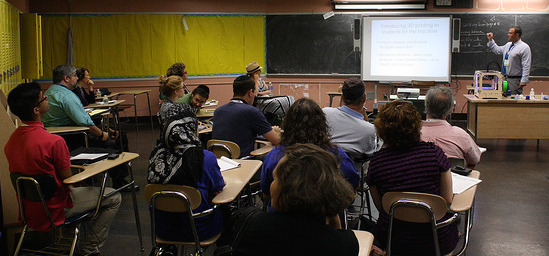
(photo via NYC Schools on flickr)
High school can be rough. Our children and students are frequently insecure, uncertain, and grasping to find their way in a new and unfamiliar environment. Some students have to deal with not only that, but also the fact that they don’t speak English.
For most English Language Learners (ELLs), one safe haven has been their English classroom, where a teacher understood their special needs and made sure no one made fun of their inevitable errors and struggles with a new language. But the most recent revision of Commissioner's Regulation Part 154, which governs how English as a second language (ESL) instruction is distributed, has largely withdrawn that support system. For example, beginning ELLs who formerly took three classes daily in direct English instruction may now have as few as one.
Instead of ESL classes, New York State purports to blend English instruction into other courses. For example, in the daily 40 minutes that an United States-born student has to study, say, the Civil War, ELLs are expected to study both the Civil War and English. So not only do they get less English instruction, but they also get less instruction in history than native speakers. Principals may see it as a win-win. They can dump ESL classes, add nothing, save money, and hope for the best.
I don’t know about you, but if I went to China tomorrow, I’d want intense instruction in Mandarin or Cantonese before I ever attempted opening a history book. I want the best for my students, and that includes as much English instruction as possible. Expecting children to master history before being able to order a pizza or even introduce themselves is remarkably short-sighted, reflecting total ignorance of language acquisition.
I know a Spanish teacher, dual-licensed in ESL, whose principal asked her if she minded the school using her class to grant ESL credit to students. Can you imagine newcomers studying Spanish and getting credit for English? Any administrator who thinks you learn English in a Spanish class may need to rethink their own accreditation. And any administrator who cynically places ELLs in situations where they won’t learn English needs to find a more suitable line of work.
A friend teaches social studies in Brooklyn. In his class, currently oversized with 41 students, he has several ELLs. There is an ESL teacher who comes in Tuesdays and Thursdays, and New York State says they are therefore getting English instruction. I have no idea how. My friend says the class is completely incomprehensible to the students. Yet there they sit, and twice a week an ESL teacher sits in the same room. According to New York State, they are therefore learning English.
This is personal for me. I’m an ESL teacher. I have gifted young colleagues in danger of losing their positions for no good reason. Under Part 154, any subject teacher can take 12 credits, teach any subject whatsoever, and have New York State assert her students are concurrently learning English. That’s magical thinking. Learning a language is an intense experience for both student and teacher. It’s inconceivable to me that ELLs will acquire not only English, but also an academic subject in the same time native English speakers acquire the subject matter alone.
We’ve finally moved on from Regents Chancellor Merryl Tisch and her particular embrace of corporate education reform. It’s time for her esteemed successor, Betty Rosa, to embrace policies that support the most vulnerable among us. In the Trump era, my students have enough to worry about.
ELLs don’t need backward, baseless policies that deprive them of fundamental support in order to save a few bucks. The city and state teachers unions, UFT and NYSUT, have resolved that newcomers need more instruction in English, not less. That’s common sense. It’s time for the Regents to awaken from their slumber and follow our lead.
***
Arthur Goldstein is an ESL teacher and UFT chapter leader for Francis Lewis High School. On Twitter @TeacherArthurG.
***
Have an op-ed idea or submission for Gotham Gazette? Email This email address is being protected from spambots. You need JavaScript enabled to view it.
GothamTalks: So Many Ways to Get Involved Locally

Gotham Gazette and New Leaders Council -- a nonpartisan, nonprofit leadership institute -- have partnered with Manhattan Neighborhood Network to create a series of video commentaries by New York City civic activists. GothamTalks is short video essays submitted through the New Leaders Council alumni network, which consists of hundreds of New Yorkers working in advocacy, government, campaigns, nonprofits, business, law, and other aspects of city life.
Like both the reporting we do at Gotham Gazette and the written op-ed columns we publish, the GothamTalks video commentaries range in subject, but are all meant to move the public discussion forward. Please watch, listen, and let us know what you think. Use #GothamTalks on social media, and tag us @GothamGazette and @NLC_NYC.
Note: The views expressed in GothamTalks are entirely those of the commentators, and not of Gotham Gazette or New Leaders Council.
************
November 10, 2017
Elizabeth Adams
Getting involved locally
Where the Mayor Opposes Affordable Housing and Neighborhood Character

Union Square tech hub image rendering via EDC
Mayor de Blasio claims that creating and preserving affordable housing in our city is a top priority for his administration. But in Greenwich Village and the East Village, he has consistently blocked rezoning plans that would help create and preserve affordable housing where little exists, and opposed eliminating loopholes that aid developers, including his campaign fundraisers, in getting around existing affordable housing provisions.
For over three years, we have asked the mayor to change zoning rules for the University Place and Broadway corridors in our neighborhood, where intense development is rapidly accelerating. Current zoning only allows luxury condos, hotels, and office buildings to be built there. As a result, a 300-foot-tall luxury condo tower has just topped out on 12th Street, with no affordable housing (under our rezoning plan, that development could have included 29,000 square feet or more of affordable housing). A slew of office towers catering to high-end firms are going up or being planned in the area at a similar scale, along with other luxury condo projects; we can only expect more of the same under the existing zoning.
Our plan calls for switching to zoning of the type that exist in other neighborhoods which incentivizes the inclusion of affordable housing in new developments, or to make that inclusion mandatory. Our zoning plan would not fundamentally change the allowable overall size of new development, but would cap new building heights at about half that of these new out-of-scale towers, preserving neighborhood scale and character.
Next door, along 3rd and 4th Avenues, we are seeking to close a loophole in the zoning for these blocks that allows developers to sidestep the existing incentives for creating affordable housing by building purely commercial buildings. That loophole recently resulted in the demolition of five modest walk-up apartment buildings with scores of housing units, many of them rent-regulated, to make way for a 300-room hotel being built by David Lichtenstein (founder and CEO of the Lightstone Group), who raised funds for the mayor and was appointed by the mayor to the Economic Development Corporation. Our zoning plan would cut the size of commercial developments in this predominantly residential neighborhood, so new development would almost certainly be residential and subject to the affordable housing incentives. Here too, those incentives could be made mandatory.
The mayor’s response? A resounding “no.” In fact, until publicly confronted about this at a recent town hall, the mayor’s planning officials even refused to meet with us. The situation is made even more urgent by the plan by the mayor and his Economic Development Corporation to rezone a nearby site to create an enormous “tech hub.” Lacking the zoning protections we are calling for, this will only accelerate the rate of high-rise condo and commercial development in the nearby residential area, with no affordable housing (the proposed tech hub site had been earmarked for affordable housing years ago to boot).
The mayor has a policy of only allowing rezonings that mandate affordable housing, for which there are strong arguments. What lacks any justification is the mayor’s insistence that such rezonings also allow vast increases in the allowable size and amount of new market-rate housing. Because our proposed rezoning does not, the mayor opposes it. But his way not only undermines the entire purpose of including affordable housing, by also flooding the area with much more high-end housing than would otherwise be built, but destroys the scale and character of neighborhoods at the same time. This is why so many communities across the city have resisted the mayor’s rezoning plans, while putting forward their own, much more reasonable ones.
If the mayor has his way, this part of the Village and East Village will retain zoning that will only lead to a vast flood of out-of-scale condos, hotels, and upscale office towers, and miss opportunities to create or preserve affordable housing where it is sorely lacking.
Under our plan, supported by every local elected official and community group, new development would have strong incentives or requirements to include affordable housing, and would remain in scale with the neighborhood without unduly taking building rights away from the developers.
So, which side are you on, Mr. Mayor?
***
Andrew Berman is Executive Director of Greenwich Village Society for Historic Preservation. On Twitter @GVSHP.
***
Have an op-ed idea or submission for Gotham Gazette? Email This email address is being protected from spambots. You need JavaScript enabled to view it.
Paid Family Leave for City Teachers Now

Mayor de Blasio visits a classroom (photo: Rob Bennett/Mayor's Office)
Every work day for the past nine school years, I have taught and learned with young people from stressed economic backgrounds as a New York City public school teacher. Every day, I confront the realities of a system that puts short-term profits over children’s well-being and the long-term health of our city’s families.
I see scars on adolescents whose parents were forced into a bind that Mayor de Blasio has described as “the impossible choice between bonding with their child and paying their bills.”
Scars on students whose parents were unable to take the time to bond with them because of economic pressures. On others whose parents did take time off, but now struggle even more to make ends meet. I see adolescent children fall behind their peers because they have to take on responsibilities at home providing childcare to infant family members so that their parents can rush back to work.
Harvard’s Center on the Developing Child confirms what those of us who work with young people know: “responsive relationships early in life are the most important factor in building sturdy brain architecture,” the neurological foundation for all future learning, behavior, and health. When parents do not have time to bond with new young ones in their lives we all suffer.
For too long, New York denied the children of all city employees access to the benefits that come from paid family leave for parent-child bonding.
Nearly two years ago, Mayor de Blasio publicly recognized the foolishness embedded in this system. He created and imposed on city managers a program that provides up to 12 weeks of paid family leave.
But that program penalized many managers with the loss of promised salary and vacation benefits. According to the city’s Independent Budget Office the program was not a cost to the city budget, rather it actually resulted in a savings to the city of close to $6 million. The mayor used his unilateral power to create a system where he got more than he gave up. That is not my understanding of how a “benefit” works.
In order to extend paid family leave to members of municipal labor unions, the city and unions must collectively bargain a new agreement. Teachers cannot sign on to the kind of one-sided plan that de Blasio instituted with managerial employees.
We know that governments can create family leave without breaking the bank. Cities across the country — including ones in the south and midwest that are not known for progressive social policy — have found ways to fund paid family leave policies for all city employees without going bankrupt. For example, Wake County, North Carolina funds the cost through the city budget.
We also know that negotiation means give and take. All of us understand the benefits of parental leave for children and families, but different teachers will have different understandings of the cost side. I’m a chapter leader in the UFT and I would love to have conversations about the appropriate costs of such a plan. We could have these conversations in our chapters and as a union if the mayor’s team would be up front about their calculations and requirements. But the team has provided none of these details publicly. I’m left to wonder if they are trying to accomplish the Mayor’s lofty goals without expending any resources to do so.
For 21 months, New York City has formally recognized the importance of paid family leave while accepting a policy that denies this benefit to our city’s educators and their children, as well as many thousands of other union employees and their families. Like a decision that restricts mail delivery for postal service workers, this hypocritical policy denies us what we provide to the rest of the city. The people who care for, educate, and support the young people of New York City should have the chance to care for, educate, and support our own children and families.
A good city takes care of the people who take care of it. We do this because it is the right thing to do, the right way to show value for the hard-working folks who make our city run. We also have a self-interest in providing services to city employees — services that make them more effective workers, services that make our city a more appealing place to live. Rather than treating teachers who want family leave like we are asking for a handout, the city should be partnering with us to find ways to support the youngest and most vulnerable of our city’s citizens without sacrificing the work we do. Rather than dragging its feet, the mayor’s team should use the political capital from his re-election to create a family leave policy for all employees.
In the mayor’s own words, “Paid parental leave means healthier and more financially stable families, more effective workplaces, and a stronger and more just city – which everyone can get behind.”
It’s time the administration got behind a real effort to create a parental leave program that works for everyone.
***
John Troutman McCrann is a math teacher at Harvest Collegiate High School in Manhattan.
***
Have an op-ed idea or submission for Gotham Gazette? Email This email address is being protected from spambots. You need JavaScript enabled to view it.
Politics, Money, and the ‘Spirit of the Law:’ Why New York Needs a Constitutional Convention
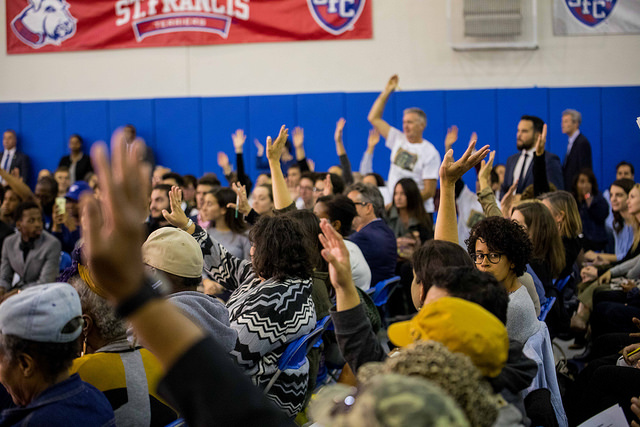
(photo: Benjamin Kanter/Mayor's Office)
The federal corruption trial of Norman Seabrook, former head of the correction officers’ union, has introduced new evidence of the contaminating role money plays in politics throughout the state. Jona Rechnitz, a wealthy real estate developer with a taste for power, became a star witness in the case after he got caught in the middle of an alleged deal that allowed Seabrook to get a kickback for investing the union’s pension funds in a risky hedge fund. Rechnitz had also been associated with allegations concerning the Port Authority and Westchester County, was found to have given expensive gifts to police brass in New York City in exchange for special treatment, and had donated so much money to Mayor Bill de Blasio’s election campaign in 2013 that he was appointed to the mayor’s inauguration committee.
In the course of testimony, Rechnitz could not seem to restrain himself in bragging about his easy access to City Hall after raising more than $150,000 for the mayor -- access the mayor partially denies. In March, de Blasio had been relieved of criminal charges in two investigations when the Manhattan District Attorney and the U.S. Attorney issued coordinated statements indicating that there was insufficient evidence to prosecute him or his staff.
In a ten-page public letter, however, District Attorney Cyrus Vance declared, “the parties involved cannot be appropriately prosecuted,” but added, “this conclusion is not an endorsement of the conduct at issue.” He elaborated, “the transactions appear contrary to the intent and spirit of the laws that impose candidate contribution limits,” further explaining that the relevant statutes “are meant to prevent corruption and the appearance of corruption in the campaign financing process.”
With all due respect to Mr. Vance, I beg to differ with his conclusion, at least in part.
“Spirit of the law” is a legal concept that commonly refers to higher order values that statutes are designed to fulfill. In this particular case, the laws in question could have been intended to limit contributions, or more generally “prevent corruption or the appearance of corruption,” but practically speaking, they are only half-hearted attempts to do either. When it comes to elections or politics, the real intent of the state law in New York is to create the illusion that legislators intend to limit the role money can play, while they incorporate loopholes to undermine effectiveness. Such a charade is the real “spirit of the law,” and one reason to seize opportunity to change it.
Let me be specific. In New York State, an individual cannot donate more than $10,300 to the campaign of a single candidate. Ostensibly, the objective here is to prevent a donor’s undue influence over an elected official. A person can, however, donate up to a $103,000 to county political committees, which in turn can support a candidate with that money and more.
District Attorney Vance had his own explaining to do last month when it was disclosed around two controversial and high profile cases that he took campaign contributions from lawyers who conduct business with his office. When asked about the practice, Vance’s response was “It’s legal.”
The sad reality is that money is the fuel of American politics. If you want to enter the political arena, the first thing you need to do is fundraise. Unless you are independently wealthy, you need to attract donors. People don’t always contribute to campaigns out of altruism to greater causes or belief in a candidate’s capacity to do good. Donors, especially big donors, expect to be granted influence that may or may not benefit them personally.
Independently wealthy candidates who can afford to spend their own money on an election bring their own problems. Mayor Michael Bloomberg spent such unfathomable amounts of money to get himself elected three times (nearly $110 million in 2009 alone) that it distorted the democratic process. (His main opponent, William Thompson, spent $10 million). Under the law, there is no limit to what a candidate can spend on his own campaign, even in New York City, which has significantly more robust campaign finance laws than at the state level.
In fact, Bloomberg had so much money that he famously gave it away. When he was in office, Bloomberg’s top deputy mayor simultaneously served as the CEO of his private philanthropic foundation, which dispersed millions of dollars to applicants for various projects. The city Conflicts of Interest Board approved the arrangement, making it legal. When Bloomberg petitioned the City Council to overturn a term limits law so he could seek a third term, there were press reports that his aides pressured beneficiaries of his philanthropy to testify on his behalf.
Governor Andrew Cuomo and the New York State Legislature have ignored appeals to enact meaningful election reforms to reduce the influence that money has in politics. In 2014, Cuomo abruptly and controversially dismissed his own Moreland Commission investigating corruption in the state. The Legislature in Albany is reputed to be one of the most corrupt and dysfunctional in the country. Over the past ten years, more than two dozen of its members have been convicted or sanctioned for wrongdoing, including the top leaders of both houses, who have been sentenced to jail (their convictions were each recently overturned based on new Supreme Court precedence, but they will be retried in 2018).
The legislative process is invested in the status quo and rigged against reform.
New Yorkers have a legal way to circumvent the legislative process by holding a constitutional convention if they vote to do so on Election Day. It is question one on the back of the ballot, where a “yes” vote would trigger the convention process.
A convention would open discussion on a range of controversial issues, and it cannot fix all that is wrong with a money-driven political process that has been further compromised by the federal judiciary. Yet, given the hidebound thinking that immobilizes Albany, a convention is the only way to get the reform ball rolling on matters that go to the heart of the democratic process and its fundamental integrity.
***
Joseph P. Viteritti is the Thomas Hunter Professor of Public Policy at Hunter College and author of The Pragmatist: Bill de Blasio’s Quest to Save the Soul of New York.
***
Have an op-ed idea or submission for Gotham Gazette? Email This email address is being protected from spambots. You need JavaScript enabled to view it.
Why Tenants Should Vote Against a Constitutional Convention
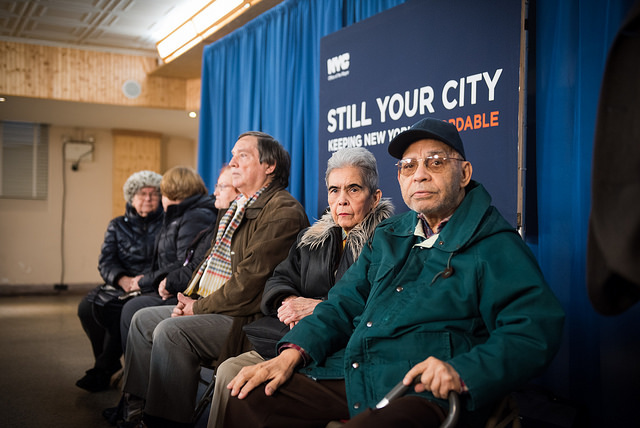
(photo via The Mayor's Office)
Every 20 years, the New York State Constitution mandates a statewide vote on whether to convene a convention to consider amending it. On Tuesday, Election Day, New Yorkers will vote “yes” or “no.” This measure, question one of three on the back of the ballot, is more important than anything on the front.
Tenants Political Action Committee debated this question at length, and despite many arguments in favor, we voted unanimously to oppose a “con con” this time around.
This was not a decision we took lightly. With a state government that is a model of dysfunction and gridlock, it is tempting to try an end-run around the governor and state Legislature to attempt necessary reforms they have refused to enact despite the stunning number of politicians who have been convicted of corruption and gone to prison.
Many New Yorkers of good will believe that a constitutional convention could force such reforms into being, and indeed that is a theoretical outcome. But the risk of a negative result for tenants and other constituencies that do not have access to piles of cash is very real.
One negative is that delegates are chosen based on the 63 state Senate districts. Because Democratic Gov. Andrew Cuomo allowed the state Senate Republicans to draw hyper-partisan district lines to preserve their shrinking majority, this could result in Republican delegates to a convention having a majority.
There is every reason to believe that the very politicians we now criticize for refusing to enact progressive reforms would control the convention. Current and former elected officials, and even lobbyists, are eligible to run, and legislators could use their superior name recognition and campaign funds to outgun grassroots candidates. Anyone who understands how Albany really works sees the probable composition of a convention as inclined to do the bidding of special interests.
Beyond the potential to water down critical protections for poor people, workers, civil rights, and wilderness, there is one possible “reform” of special importance to tenants: allowing special interests to place legislation directly on the ballot by petition. Many states allow this already. New York does not.
If such a referendum process was added to the state constitution, it is not hard to imagine the real estate lobby initiating a statewide referendum to terminate rent control laws, which only exist in New York City and the downstate suburbs. In fact, this is exactly how Massachusetts ended rent controls in 1994, passing a statewide referendum 52 to 48 percent. Only three cities in the eastern part of the state had rent control – Boston, Cambridge and Brookline – and the landlords’ multi-million-dollar media campaign in central and western Massachusetts made much of the fact that the mayor of Cambridge lived in a rent-controlled apartment.
The analogy with New York is clear. New York City landlords would spend any amount to get rid of rent regulations via statewide ballot initiative. And if they failed the first time, they would keep trying.
Some progressive groups take the position that this would be a good change in New York. They should consider the downside. Ballot initiatives are easier to mount by groups with superior resources, and easier for them to win for the same reason.
We think there is a better way: in the last year, thousands of New Yorkers have become involved in organizations that work to raise political awareness and seek to hold politicians accountable, with a focus on swing districts and turncoat Democrats. The energy coming out of these efforts is inspiring. Let’s harness it to elect better legislators and change our laws at last.
***
Michael McKee is treasurer of the Tenants Political Action Committee. On Twitter @TenantsPACNY.
***
Have an op-ed idea or submission for Gotham Gazette? Email This email address is being protected from spambots. You need JavaScript enabled to view it.
GothamTalks: Why You Should Vote in Local Elections

Gotham Gazette and New Leaders Council -- a nonpartisan, nonprofit leadership institute -- have partnered with Manhattan Neighborhood Network to create a series of video commentaries by New York City civic activists. GothamTalks is short video essays submitted through the New Leaders Council alumni network, which consists of hundreds of New Yorkers working in advocacy, government, campaigns, nonprofits, business, law, and other aspects of city life.
Like both the reporting we do at Gotham Gazette and the written op-ed columns we publish, the GothamTalks video commentaries range in subject, but are all meant to move the public discussion forward. Please watch, listen, and let us know what you think. Use #GothamTalks on social media, and tag us @GothamGazette and @NLC_NYC.
Note: The views expressed in GothamTalks are entirely those of the commentators, and not of Gotham Gazette or New Leaders Council.
************
November 3, 2017
Max Markham
Voting in Local Elections
New York’s Con Con Ballot is Biased
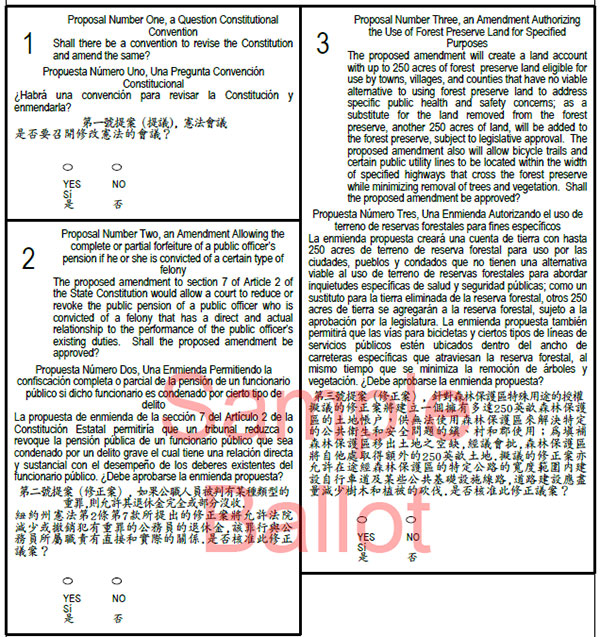
(sample ballot excerpt - image via NYC Board of Elections)
When New Yorkers vote on Nov. 7 on whether to call a state constitutional convention, the question they will see on the ballot is: “Shall there be a convention to revise the constitution and amend the same?” This ballot text is the only form of convention related media that every voter will see immediately before voting—and when many voters are most impressionable.
Unfortunately, this seemingly innocuous question is highly biased because it doesn’t specify whether it refers to the federal or New York state constitution. Close to 100% of New Yorkers know they have a national constitution, but less than half know they have a state constitution. Thus, millions of New Yorkers may go to the polls assuming that what is being referred to is the United States Constitution. And since Americans are taught to revere their federal constitution like the bible, the question could just as well have been worded: ‘Shall the Bible, written by god, be rewritten?”
In short, the ballot language is strongly biased against a “yes” vote.
In 1846, when this language was first inserted into New York’s Constitution, it wasn’t biased in the same sense that it wasn’t then biased to refer to voters as white males. Only since the Civil War, with the growing chasm between knowledge of the federal and New York state constitutions, did it become biased.
Prior to the Civil War and the passage of the 14th Amendment to the federal constitution (which extended federal rights protections to the states), states played a much greater role in American government. The pre-Civil War era was one of state rights, state power, and state glory. The federal government was often subservient to state government, provided far fewer services, and was even often viewed by some politicians as a stepping stone to serving in state government. Since the state and national constitutions were largely co-equal, students studied both. State constitutional reform was also often in the news, partly because New York’s constitution had been the subject of high-profile revision during every middle-aged adult’s lifetime (e.g., conventions in 1777, 1801, 1821, and 1846), something that wasn’t true of the federal constitution. Between 1803 and 1865 there were no federal constitutional amendments, let alone high profile conventions.
Today, in contrast, New York’s constitution is often treated as a ragamuffin. Those who attend New York’s K-12 schools, visit its leading museums, and watch its history on TV, will rarely if ever be told that New York even has a constitution, let alone what’s in it or how New York’s nine state constitutional conventions shaped it. In contrast, the federal constitution has retained and even raised its position atop its Bible-like pedestal.
To be fair, by the time most voters enter the voting booth on Nov. 7, they will know they have a state constitution. The ballot abstract provided by the New York State Board of Elections does explicitly refer to the constitution as a “State Constitution.” But the fraction of voters who read the abstract will be exposed to an arguably even worse type of bias. For the abstract describes only the cost of a convention; nowhere does it describe any benefits. Thus, a rational person who reads this description would infer that a convention only involves costs—which mimics the message being promoted by legislative leaders and others who are leading the campaign to oppose a “yes” vote.
Instead of focusing on a convention’s costs and other procedural details, the ballot abstract should explain the convention’s democratic purpose in the context of the constitution. This would include explaining why New York’s framers provided for two methods of constitutional amendment, why New York courts have ruled that calling a convention is an inalienable right of the people, and why New York’s constitution (Article XIX, §3) specifies that when there are two conflicting amendments ratified by the people, the convention-proposed one trumps the legislature-proposed one.
This year Evan Davis, a leading advocate for calling a convention and former Counsel to Governor Mario Cuomo, sued New York State’s Board of Elections regarding its placement of the convention referendum question on the ballot. The suit’s admirable goal was to have the question more prominently placed on the ballot. This would signal its importance to voters and thus encourage them to vote on it. The remedy sought, which the court denied, was to have the ballot question placed on the front side of the ballot, where voters choose candidates.
A better proposed remedy, which would have avoided forcing judges to decide on the relative importance of candidate versus referendum questions, would have been to place the two different categories of questions on different ballots. This remedy would have treated candidate and convention questions equally, and it is used by legislators in other states when they want to discourage voters from leaving a legislature-initiated constitutional amendment question blank.
On the other hand, since the convention question embodies New Yorkers’ most fundamental of all democratic rights—the people’s right to constitutional reform—it should arguably be given the most high-profile ballot position. Many states have granted it that position by calling a special election, but that remedy is both undesirable (e.g., it reduces turnout) and illegal (New York’s constitution specifies that the convention referendum be held at a general election).
My own preferred approach would be to eliminate government control over ballot media—a power that government officials routinely abuse despite claiming to practice objective ballot journalism. But as I argued in a prior column, New York currently lacks the election infrastructure to make this reform viable. Fixing that antediluvian infrastructure should be a priority for any convention the voters approve.
With only days to go before the election, the press should educate the public on the most basic constitutional and convention facts that New York’s public and non-profit educational institutions have shamefully failed to teach.
First, a New York state constitution exists, and the convention referendum refers to it.
Second, the New York constitution greatly differs from the federal constitution. It is about seven times as long (about 8,000 versus 55,000 words); full of provisions made obsolete by new federal laws; pockmarked with hundreds of legislatively-passed amendments that make the document incoherent and unreadable; and shunned by New York’s most prestigious educational institutions, including schools and museums, as unworthy of their educational efforts.
Third, the framers of New York’s convention process believed that it had not only costs but great benefits, as it is New York’s only available mechanism to bypass the Legislature’s gatekeeping power over constitutional amendment—an essential component of New Yorkers’ right of constitutional reform.
Fourth, the question’s obscure placement on the ballot should only signal incumbent state officials’ political self-interest, not the question’s importance as a safeguard of a vital democratic right--the people’s right to alter their constitution in the face of a legislature’s opposition. There is no more important question on the ballot, as signaled by the many millions of dollars New York’s most powerful legislative lobbying groups are spending to defeat it.
Addendum: Readers, including Karen Biesanz from the League of Women Voters, and Evan Davis from the Committee for a Constitutional Convention, have pointed out to me that the wording of the ballot question also misleadingly implies that a convention will not only propose but ratify amendments. In Ms. Biesanz’s words, it “implies that there WILL be revisions/amendments” despite a convention’s proposals not being “a done deal till the electorate votes to accept [them].” They have made an excellent point. The ballot’s wording bolsters the opposition’s strategy of implying that the people lack the power to vote a convention’s proposals up or down; it should have clarified that the people retain a veto power over any convention proposed constitutional reforms.
***
J.H. Snider is the author of "Does the World Really Belong to the Living? The Decline of the Constitutional Convention in New York and Other U.S. States 1776-2015" and editor of The New York State Constitutional Convention Clearinghouse.
***
Have an op-ed idea or submission for Gotham Gazette? Email This email address is being protected from spambots. You need JavaScript enabled to view it.
Vote ‘Yes’ on Question 2 and Send Albany a Message
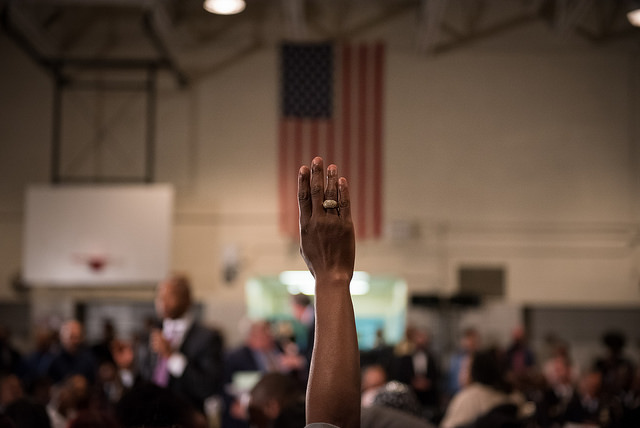
(photo: Edwin J. Torres/NYC Mayor's Office)
This Election Day, New Yorkers have an opportunity to vote for ethics in government. You won’t see the words “anti-corruption” or “integrity” on the ballot, but make no mistake – these essential elements of trust in government are at the core of Ballot Proposal 2, which will be put before voters on November 7.
Proposal 2 -- which can be found on the back of your ballot with two other questions -- seeks the public’s approval to amend our state constitution to “allow a court to reduce or revoke the public pension of a public officer who is convicted of a felony that has a direct and actual relationship to the performance of the public officer’s existing duties.”
If a majority of New Yorkers vote “yes” on Proposal 2, no longer will pension dollars automatically go to felons sitting in jail who have thoroughly violated their oaths of office. For crimes committed after the enactment of the constitutional amendment, not only would taxpayer money be saved, but also the message would go out that the Empire State no longer tolerates – and bankrolls – corruption.
When I proposed a pension forfeiture constitutional amendment during my first year in the State Assembly, 2013, I was told there was no chance of this idea passing in Albany. Criminal conduct among elected officials was all too common. Many ethics reforms had gone nowhere in our state capitol. The State Assembly was led by Sheldon Silver and the State Senate headed by Dean Skelos, two men who would be forced from office after being embroiled in corruption scandals. But broad backing from the citizens of New York helped this idea overcome many hurdles, leading to the 2016 and early 2017 legislative passage of this proposed constitutional amendment, which placed the measure on this November’s ballot.
A vote in favor of Proposal 2 would send a clear message to state officials that we no longer tolerate corruption, forewarning them of what is to come if they violate the public trust they’ve sworn to uphold. Proposal 2 empowers voters to respond by putting ethics reform directly in our state constitution. (Don’t confuse this vote with the vote on Proposal 1, which asks whether New York State should hold a constitutional convention – a convention would likely deal with many other topics beyond ethics reform.)
If voters overwhelmingly support the pension forfeiture amendment, Proposal 2, New Yorkers will then be on firm footing to pressure the State Assembly and Senate to take up other needed reforms. These should include closing the “LLC loophole” that allows the use of limited liability corporations to funnel massive amounts of cash into election campaigns, and banning companies and individuals bidding on government contracts from making campaign contributions to state elected officials who have authority to approve or reject those bids.
A big win this Election Day for Proposal 2 would demonstrate that the public wants ethics reform. Too many people in Albany believe that ethics reform is something voters don’t care about. Prove them wrong – vote YES on Proposal 2.
***
David Buchwald is a New York State Assemblyman from White Plains. He represents over 130,000 residents of Westchester County. On Twitter @DavidBuchwald.
***
Have an op-ed idea or submission for Gotham Gazette? Email This email address is being protected from spambots. You need JavaScript enabled to view it.
Open Primaries and Overcoming the Racial Divide the Parties Prop Up
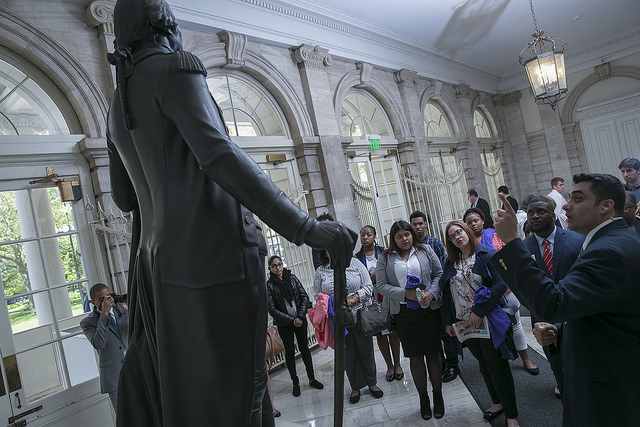
(photo: William Alatriste/City Council)
Today the dominance of the two major parties has frozen the country’s political development along a racial divide: the Republican Party uses law and order, tax cuts and anti-immigrant rhetoric to capture white voters, and the Democratic Party depends on high black voter turnout to win elections, while failing to address the ongoing inequality between people of color and white people. Pollster Cornell Belcher has found that 63% of black people feel taken for granted by the Democratic Party. The current highly partisan political environment is producing both government dysfunction and a general sense of dread that the county is moving backward.
The American people have been so manipulated and divided by politicians and our political process so over-determined by two-party control that for ordinary people of good will to meaningfully come together requires a wholesale break from politics as usual. We should not confuse multiracial solidarity—when people of different races come together to fight for a common goal—with the dynamic of political party constituency groups such as African-American, Latino, LGBT people, and women making demands within the Democratic Party and fighting each other for the attention and resources of the party and its elected officials.
I recently had a conversation with a close friend whose history is very different from my own. We agreed that perhaps the most dangerous effect of the current political environment is that people of different races are being pushed further and further apart. My friend Nancy, who is white, grew up under segregation in the 1950s in small towns all over northeast Arkansas. As a child, she "experienced and witnessed and joined the fight for integration in the South.” Fifty miles from her home and 20 years earlier, the Southern Tenant Farmers’ Union was formed, a federation of tenant farmers that united black and white sharecroppers to reform the system of sharecropping and improve the lives of all its members. Women played a key role in the development of this organization. As we talked about this, Nancy said to me, “I think this history is good to have in our tool box. I certainly will not forget where I come from. This history is important to me because I witnessed the fight for integration in the South.”
I grew up in the black community of south Philadelphia in the 1960s. My grandmother, Adell Chandler, owned and operated a large soul food restaurant that was open 24 hours a day and was a pillar of the cultural and social life of the community. She was a supporter of the civil rights movement and she encouraged me to become a doctor. I dreamed of becoming a doctor who could be a role model and help transform the conditions of the black poor.
I remember hearing Dr. King’s voice on the radio. It was his unbending stance for nonviolence, his courage, his willingness to sacrifice his life, his humble yet soaring commitment to fight against poverty, racism, and war that inspired people of all colors to take a stand. When Dr. King asked people to come to Selma to march for voting rights for African-Americans, Americans from across the country responded.
Nancy and I are both independents who are activists in the progressive wing of the independent political movement founded jointly by Dr. Lenora Fulani—who ran for president as an independent and in 1988 became the first woman and African-American to appear on the presidential ballot in all 50 states—and Jackie Salit, the author of Independents Rising and the president of Independent Voting, the country’s largest network of independent voter activists. These two women are working to build multiracial solidarity by creating independent tools to revitalize American democracy and transform our political culture to one of inclusion and opportunity for all.
Multiracial solidarity stretches throughout American history from the founding of the country in which black soldiers fought alongside white soldiers in the Revolutionary War, to the anti-slavery movement of black and white abolitionists who worked together and built the Underground Railroad. And examples from the Civil War, when Union officers like Thomas Wentworth Higginson and Robert Gould Shaw led regiments of black soldiers, many of whom were recently emancipated slaves (Shaw died fighting alongside his black troops).
A little-known demonstration that preceded the modern civil rights movement was led in January 1939 by Owen Whitfield, an African-American preacher and organizer of the Southern Tenant Farmer’s Union. He led the Missouri Sharecropper Roadside Demonstration, where black and white homeless sharecropping families camped out on the side of the road in the dead of winter as a means of getting the government’s attention to the vast poverty and injustice for tenants who were pushed off the land by planters. In the face of the segregated south they stayed together and though the public demonstration was crushed by the state police, it remains an inspiring example of poor people crossing the racial divide to stand in solidarity and demand justice.
Today in most states there is a political divide between the Democratic and Republican parties that corresponds to a racial divide in which people live in segregated communities.
A recent New York Times article on the obstacles to getting the governor, the mayor and the state Legislature to agree on a plan to invest in New York City's badly aging subway noted: "The future of the nation's busiest subway system, which has become engulfed in crisis, could well depend on New York State lawmakers…who live hundreds of miles from the city.”
The distance between New York City and much of the rest of the state is not only geographic, it is also a racial divide that is sustained by the parties. Though people of color live throughout New York State and New York City is racially and economically diverse, downstate New York City where more people of color live is dominated by the Democratic Party and upstate New York, where fewer people of color live, is dominated by the Republican Party. This arrangement maintains the parties’ duopoly control and both parties have carefully protected it, including through gerrymandering of districts.
In a closed primary state like New York, where party insiders control the process of voting, only party members are allowed to vote in the corresponding primaries. Over 3 million “independent” voters are excluded from primary voting as a result. Of those, 35% are millennial voters, 33% are Asian voters, 20% are Latino voters and 18% are African-American. Under these exclusionary, partisan elections, the New York State Legislature has proven itself to be one of the most dysfunctional and corrupt state governments in the country.
This November, New Yorkers will have an opportunity that only comes around every 20 years: to vote “yes” on a constitutional convention, through a ballot referendum question on Election Day, and break free of the constraints to begin a process that puts reforms such as open primaries in the New York State Constitution.
In contrast, California has nonpartisan open primaries, passed by the voters in 2010. The impact has been significant. People of color are winning some local elections in majority white districts and California is leading the nation in passing effective government reforms. Moreover, under its open system two women - one African-American and one Latino -- faced off in the general election for a U.S. Senate seat in 2016. Kamala Harris, the African-American of the two, won to become the junior senator from California.
Americans can only truly come together if we can build a democratic process that empowers all voters outside the framework of a political party. Nonpartisan structural reform such as open primaries provides that opportunity.
Forty-three percent of American voters now self-identify as independents and many people, no matter how they identify, want the chance to vote and to participate in politics in new ways. The government dysfunction we see in Washington will not be reformed from within the parties. The future of our democracy depends on the American people carrying it forward. Those stepping outside the parties are leading the way to build bridges rather than walls.
***
Dr. Jessie Fields is a Harlem based physician, an organizer with the New York City Independence Clubs and a board member of Open Primaries, which advocates for nonpartisan election reform.
***
Have an op-ed idea or submission for Gotham Gazette? Email This email address is being protected from spambots. You need JavaScript enabled to view it.